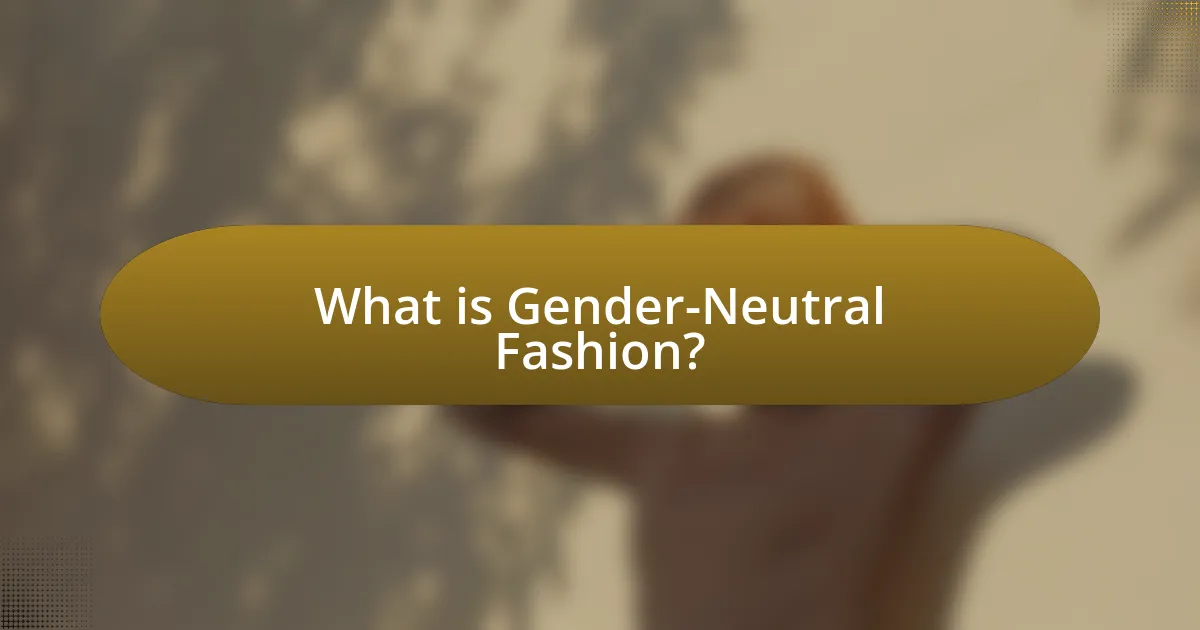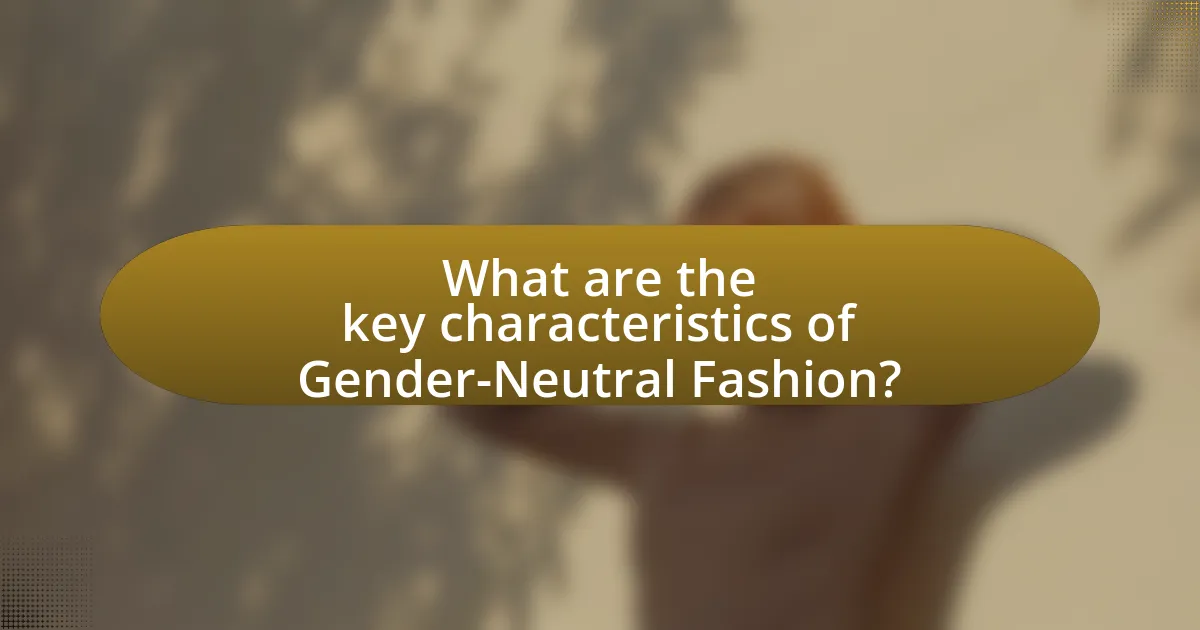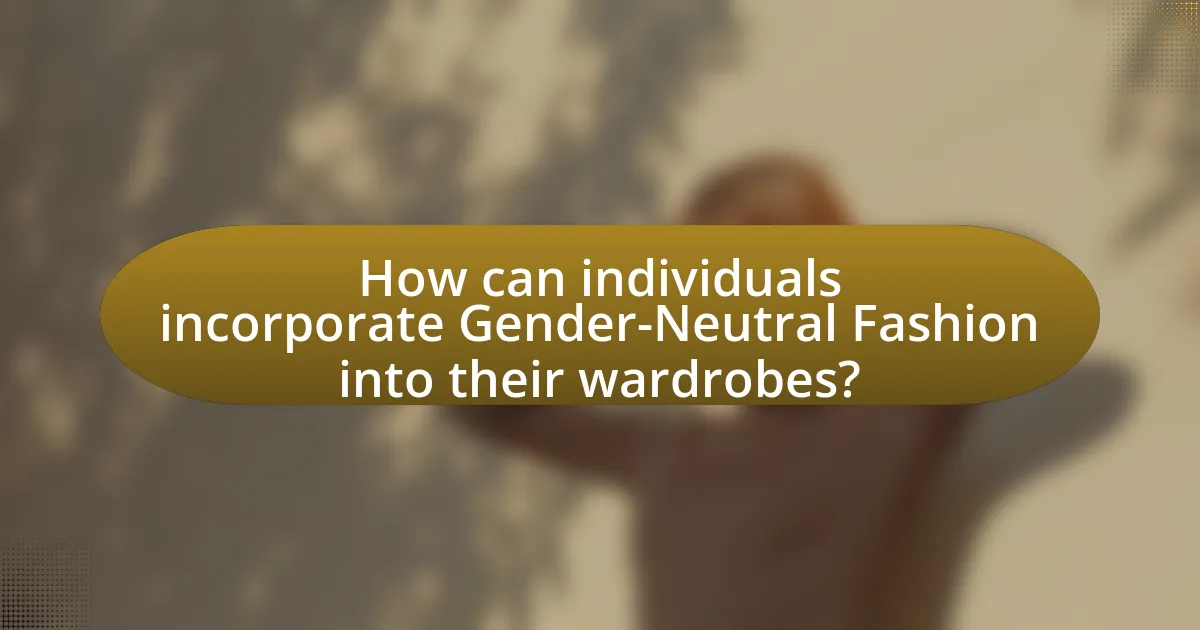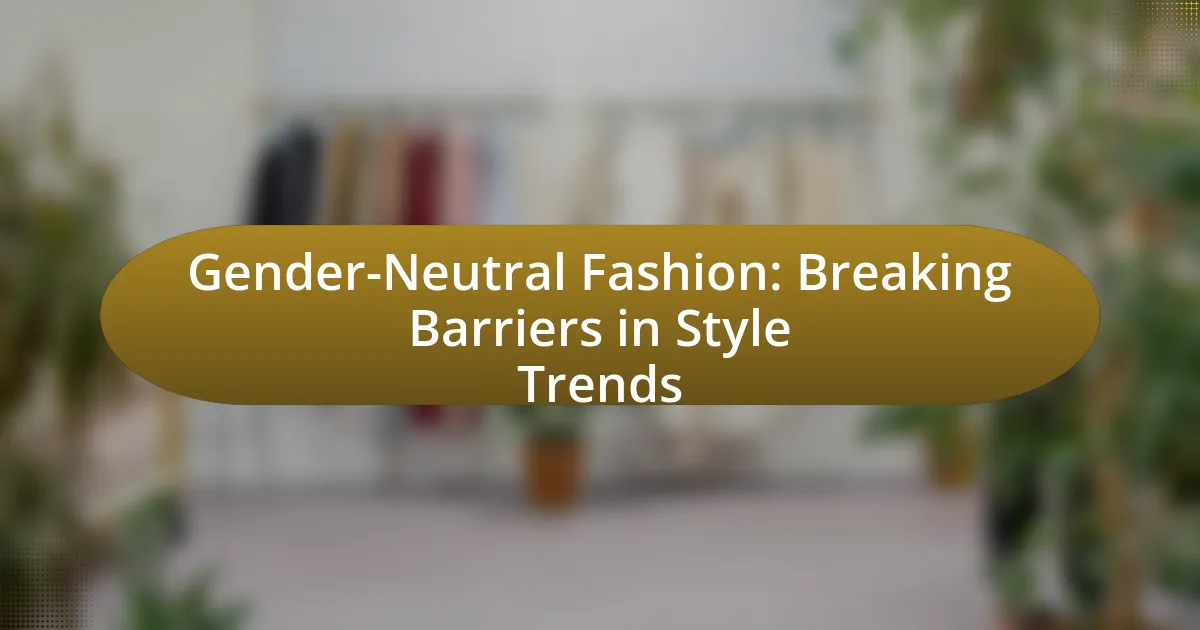Gender-neutral fashion is a clothing movement designed for individuals regardless of their gender identity, promoting inclusivity and challenging traditional gender norms. This article explores the emergence of gender-neutral fashion as a response to evolving societal attitudes, highlighting key cultural shifts, historical influences, and the importance of self-expression. It examines the characteristics of gender-neutral clothing, the leading brands and designers in this space, and practical tips for incorporating gender-neutral styles into personal wardrobes. Additionally, the article addresses challenges faced in adopting gender-neutral fashion and discusses future trends, including sustainability and technological advancements that will shape this inclusive fashion landscape.

What is Gender-Neutral Fashion?
Gender-neutral fashion refers to clothing designed to be worn by individuals regardless of their gender identity, promoting inclusivity and breaking traditional gender norms. This fashion movement emphasizes styles that are not specifically tailored for men or women, allowing for a more fluid expression of personal identity. The rise of gender-neutral fashion is supported by cultural shifts towards acceptance of diverse gender identities, with brands increasingly offering unisex collections that cater to a broader audience.
How did Gender-Neutral Fashion emerge as a trend?
Gender-neutral fashion emerged as a trend in response to evolving societal attitudes towards gender identity and expression. The late 20th century saw a shift in cultural norms, with movements advocating for LGBTQ+ rights and gender fluidity gaining momentum. This cultural backdrop encouraged designers and brands to create clothing that transcended traditional gender binaries, leading to the rise of unisex collections and gender-neutral lines. Notably, brands like Rad Hourani and Telfar have been at the forefront, showcasing collections that emphasize inclusivity and versatility. The increasing visibility of non-binary and genderqueer individuals in media further solidified the demand for fashion that reflects diverse identities, making gender-neutral fashion a significant and lasting trend in the industry.
What cultural shifts contributed to the rise of Gender-Neutral Fashion?
The rise of gender-neutral fashion is primarily attributed to cultural shifts towards inclusivity and the rejection of traditional gender norms. Increasing visibility of LGBTQ+ communities and movements advocating for gender equality have challenged conventional ideas of masculinity and femininity in clothing. Additionally, the influence of social media has allowed diverse voices to promote non-binary identities and styles, leading to a broader acceptance of gender fluidity in fashion. The fashion industry has responded by creating collections that cater to all genders, reflecting a societal trend towards breaking down barriers and embracing individuality.
How do historical fashion movements influence current gender-neutral styles?
Historical fashion movements significantly influence current gender-neutral styles by challenging traditional gender norms and promoting inclusivity. For instance, the 1960s and 1970s saw the rise of unisex clothing, with designers like Yves Saint Laurent introducing pieces such as the women’s tuxedo, which blurred gender lines. This historical context laid the groundwork for contemporary designers who now incorporate elements from various eras, such as oversized silhouettes and androgynous cuts, into gender-neutral collections. Additionally, the punk movement’s defiance of societal norms has inspired modern fashion to embrace non-binary aesthetics, further validating the evolution of gender-neutral styles today.
Why is Gender-Neutral Fashion important in today’s society?
Gender-neutral fashion is important in today’s society because it promotes inclusivity and challenges traditional gender norms. By offering clothing options that are not confined to male or female categories, gender-neutral fashion allows individuals to express their identity freely, fostering a sense of belonging and acceptance. This shift is supported by a growing consumer demand for diversity in fashion, with studies indicating that 62% of Gen Z consumers prefer brands that reflect their values, including gender inclusivity. Furthermore, major fashion brands are increasingly adopting gender-neutral lines, reflecting a broader cultural movement towards equality and self-expression.
What impact does Gender-Neutral Fashion have on self-expression?
Gender-neutral fashion significantly enhances self-expression by allowing individuals to choose clothing that reflects their personal identity without the constraints of traditional gender norms. This fashion movement promotes inclusivity and diversity, enabling people to express themselves authentically, regardless of societal expectations. Research indicates that 62% of consumers prefer brands that offer gender-neutral options, highlighting a growing demand for styles that cater to individual expression rather than binary classifications. By breaking down these barriers, gender-neutral fashion empowers individuals to embrace their unique styles, fostering a sense of freedom and confidence in their self-presentation.
How does Gender-Neutral Fashion challenge traditional gender norms?
Gender-neutral fashion challenges traditional gender norms by promoting clothing that is not restricted by societal expectations of masculinity or femininity. This movement encourages individuals to express their identity through style without conforming to binary gender classifications. For instance, brands like Telfar and Rad Hourani have gained recognition for their unisex designs, which blur the lines between male and female attire. Research indicates that the rise of gender-neutral fashion reflects a broader cultural shift towards inclusivity, with a 2021 study from the Journal of Fashion Marketing and Management highlighting that 62% of consumers support brands that offer gender-neutral options. This evidence underscores how gender-neutral fashion not only disrupts conventional norms but also aligns with evolving societal values regarding gender identity and expression.

What are the key characteristics of Gender-Neutral Fashion?
Gender-neutral fashion is characterized by its inclusivity, versatility, and lack of gender-specific design elements. This style transcends traditional gender norms by offering clothing that can be worn by anyone, regardless of their gender identity. Key features include unisex silhouettes, neutral color palettes, and functional designs that prioritize comfort and practicality over conventional gendered aesthetics. The rise of gender-neutral fashion is supported by cultural shifts towards acceptance of diverse gender identities, as seen in the increasing visibility of non-binary and gender-fluid individuals in media and fashion.
How do clothing designs reflect gender neutrality?
Clothing designs reflect gender neutrality by incorporating unisex silhouettes, neutral color palettes, and versatile styles that do not conform to traditional gender norms. For instance, many contemporary brands, such as Telfar and Rad Hourani, create collections that feature oversized fits and androgynous cuts, allowing individuals of any gender to wear the same pieces comfortably. This approach challenges the binary perception of clothing, promoting inclusivity and self-expression. Additionally, the rise of gender-neutral fashion is supported by market research indicating that 56% of consumers prefer brands that offer gender-neutral options, highlighting a significant shift in consumer preferences towards inclusivity in fashion.
What materials and colors are commonly used in gender-neutral collections?
Gender-neutral collections commonly utilize materials such as cotton, linen, and polyester, along with colors like black, white, gray, and earth tones. These materials are chosen for their versatility and comfort, appealing to a broad audience regardless of gender. The color palette is often neutral to promote inclusivity and allow for easy mixing and matching, aligning with the principles of gender-neutral fashion that prioritize functionality and style over traditional gender norms.
How do fit and silhouette play a role in gender-neutral fashion?
Fit and silhouette are crucial in gender-neutral fashion as they determine how clothing interacts with the body, allowing for versatility and inclusivity. Gender-neutral fashion often employs relaxed fits and fluid silhouettes that do not conform to traditional gender norms, enabling individuals to express their identity without restriction. For instance, oversized garments and unstructured shapes are commonly used to create a sense of comfort and freedom, appealing to a broader audience. This approach is supported by the growing trend of brands like Telfar and Rad Hourani, which emphasize unisex designs that prioritize fit and silhouette over gender-specific tailoring, reflecting a shift towards more inclusive fashion practices.
What brands are leading the way in Gender-Neutral Fashion?
Brands leading the way in gender-neutral fashion include Telfar, Rad Hourani, and Gender Free World. Telfar is known for its inclusive designs and unisex bags, which have gained significant popularity and recognition in the fashion industry. Rad Hourani focuses on unisex clothing that transcends traditional gender norms, emphasizing versatility and individuality. Gender Free World offers a range of clothing that is explicitly designed to be gender-neutral, promoting inclusivity in fashion. These brands exemplify the shift towards breaking barriers in style trends by challenging conventional gender classifications in clothing.
Which emerging designers are making an impact in this space?
Emerging designers making an impact in gender-neutral fashion include Telfar Clemens, known for his inclusive designs and unisex bags, and Palomo Spain, which blends traditional menswear with feminine elements. These designers challenge conventional gender norms in fashion, as evidenced by Telfar’s brand motto, “It’s not for you, it’s for everyone,” emphasizing accessibility and inclusivity. Palomo Spain’s collections often feature fluid silhouettes that appeal to a diverse audience, showcasing the growing acceptance of gender-neutral styles in the fashion industry.
How do established brands adapt to include gender-neutral options?
Established brands adapt to include gender-neutral options by redesigning their product lines to eliminate traditional gender distinctions in clothing and accessories. This adaptation often involves creating unisex collections that feature neutral colors, versatile styles, and inclusive sizing, appealing to a broader audience. For instance, brands like Zara and H&M have launched gender-neutral lines that focus on minimalist designs, allowing consumers to mix and match items regardless of gender. Additionally, market research indicates that 56% of Gen Z consumers prefer brands that offer gender-neutral options, prompting established brands to respond to this demand by integrating such offerings into their core strategies.

How can individuals incorporate Gender-Neutral Fashion into their wardrobes?
Individuals can incorporate gender-neutral fashion into their wardrobes by selecting versatile clothing items that are not specifically designed for one gender. This includes choosing unisex pieces such as oversized shirts, tailored trousers, and neutral-toned outerwear that can be styled in various ways. Research indicates that the rise of gender-neutral fashion reflects a broader societal shift towards inclusivity, with brands like Telfar and Rad Hourani leading the way in offering collections that appeal to all genders. By prioritizing comfort and personal expression over traditional gender norms, individuals can create a wardrobe that aligns with contemporary fashion trends while promoting equality.
What are some practical tips for creating a gender-neutral wardrobe?
To create a gender-neutral wardrobe, focus on versatile pieces that can be styled in multiple ways. Start by selecting clothing items such as oversized shirts, unisex jeans, and neutral-toned sweaters that appeal to all genders. Incorporate layering options like cardigans and jackets that can be worn over various outfits, enhancing adaptability. Choose footwear that is not gender-specific, such as sneakers or ankle boots, to maintain a cohesive look. Accessories like hats, scarves, and bags should also be chosen for their functionality rather than gender association. This approach aligns with the growing trend of inclusivity in fashion, as seen in brands that prioritize unisex collections, reflecting a shift towards breaking traditional gender norms in style.
How can layering techniques enhance gender-neutral outfits?
Layering techniques enhance gender-neutral outfits by allowing for versatile combinations that can be tailored to individual preferences without adhering to traditional gender norms. This approach enables the blending of various styles, fabrics, and colors, creating unique looks that express personal identity rather than conforming to binary fashion standards. For instance, layering oversized shirts with fitted trousers or combining dresses with jackets can create a balanced silhouette that appeals to all genders. Additionally, layering can accommodate different body types and comfort levels, making it a practical choice for inclusive fashion.
What accessories complement gender-neutral fashion choices?
Accessories that complement gender-neutral fashion choices include unisex bags, minimalist jewelry, and versatile footwear. Unisex bags, such as crossbody or tote styles, provide functionality and style without adhering to traditional gender norms. Minimalist jewelry, like simple rings or bracelets, enhances outfits without being overtly masculine or feminine. Versatile footwear, including sneakers and loafers, offers comfort and can be paired with various outfits, making them suitable for any gender expression. These accessories support the inclusive nature of gender-neutral fashion by prioritizing functionality and aesthetic over gender-specific designs.
What challenges might one face when adopting Gender-Neutral Fashion?
Adopting gender-neutral fashion presents challenges such as societal stigma, limited availability of options, and difficulties in personal expression. Societal stigma can lead to negative perceptions and discrimination against individuals who choose to wear gender-neutral clothing, as traditional gender norms remain deeply ingrained in many cultures. Limited availability of options often arises from a lack of mainstream retailers offering gender-neutral lines, making it harder for consumers to find suitable clothing that aligns with their preferences. Additionally, individuals may struggle with personal expression, as navigating a wardrobe that defies conventional gender categories can create uncertainty about style choices and identity representation. These challenges highlight the complexities involved in embracing gender-neutral fashion in a society that often prioritizes binary gender distinctions.
How can individuals overcome societal perceptions of gendered clothing?
Individuals can overcome societal perceptions of gendered clothing by actively choosing to wear garments that defy traditional gender norms. This can be achieved through personal expression, such as selecting clothing based on comfort and preference rather than societal expectations. Research indicates that visibility and representation of gender-neutral fashion in media and public spaces can significantly influence societal acceptance, as seen in the rise of brands like Telfar and gender-neutral collections from major retailers. By promoting and participating in inclusive fashion events, individuals can further challenge stereotypes and encourage a broader acceptance of diverse clothing choices.
What are common misconceptions about Gender-Neutral Fashion?
Common misconceptions about gender-neutral fashion include the belief that it is solely unisex clothing or that it lacks style and sophistication. Many people assume that gender-neutral fashion only consists of baggy or oversized garments, which overlooks the diverse range of designs that cater to various body types and personal aesthetics. Additionally, some think that gender-neutral fashion is a recent trend, while in reality, it has historical roots in movements advocating for gender equality and self-expression, dating back to the early 20th century. This misunderstanding can limit appreciation for the creativity and inclusivity that gender-neutral fashion embodies.
What are the future trends in Gender-Neutral Fashion?
Future trends in gender-neutral fashion include increased inclusivity, sustainable materials, and the rise of unisex collections. As societal norms evolve, brands are focusing on designs that cater to all genders, promoting a more inclusive approach to fashion. The use of sustainable materials is also gaining traction, with consumers increasingly demanding eco-friendly options. Additionally, major fashion houses are launching unisex collections, reflecting a shift towards breaking traditional gender norms in clothing. This trend is supported by market research indicating a growing consumer preference for gender-neutral options, highlighting the industry’s response to changing cultural dynamics.
How might technology influence the evolution of gender-neutral styles?
Technology significantly influences the evolution of gender-neutral styles by enabling innovative design processes and broadening access to diverse fashion choices. Advanced manufacturing techniques, such as 3D printing and digital textile printing, allow designers to create unisex clothing that challenges traditional gender norms. For instance, brands like Telfar and Rad Hourani utilize technology to produce versatile pieces that cater to all genders, reflecting a shift in consumer demand for inclusivity. Additionally, e-commerce platforms and social media facilitate the dissemination of gender-neutral styles, allowing consumers to discover and adopt these trends globally, thus accelerating their acceptance in mainstream fashion.
What role will sustainability play in the future of Gender-Neutral Fashion?
Sustainability will play a crucial role in the future of gender-neutral fashion by driving the industry towards eco-friendly practices and materials. As consumers increasingly prioritize ethical consumption, brands will need to adopt sustainable production methods, such as using organic fabrics and reducing waste, to meet this demand. For instance, a report by McKinsey & Company indicates that 67% of consumers consider sustainability when making fashion purchases, highlighting the importance of eco-consciousness in shaping future trends. This shift not only aligns with consumer values but also encourages innovation in design and manufacturing processes, ultimately leading to a more responsible and inclusive fashion landscape.
What are the best practices for embracing Gender-Neutral Fashion?
The best practices for embracing gender-neutral fashion include selecting versatile clothing that transcends traditional gender norms, such as oversized silhouettes, unisex designs, and neutral color palettes. These choices promote inclusivity and allow individuals to express their identity without conforming to societal expectations. Research indicates that the global market for gender-neutral clothing is growing, reflecting a shift in consumer preferences towards more inclusive fashion options. Brands like Telfar and Rad Hourani exemplify successful gender-neutral lines, demonstrating that such practices resonate with a diverse audience and contribute to a more equitable fashion landscape.

Leave a Reply